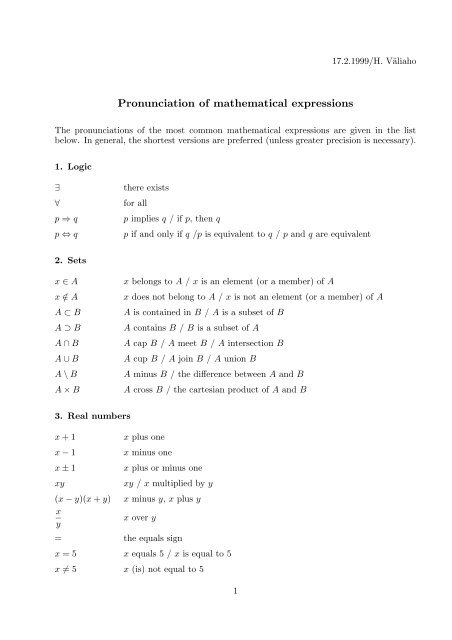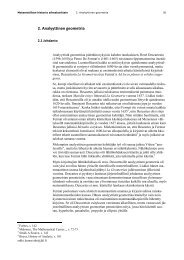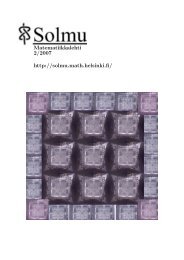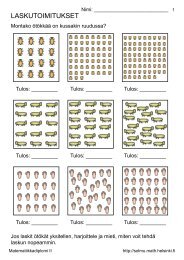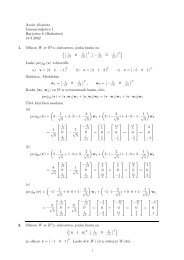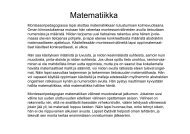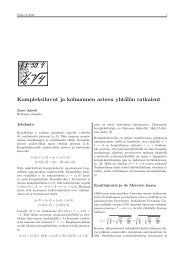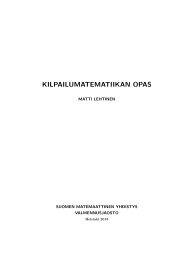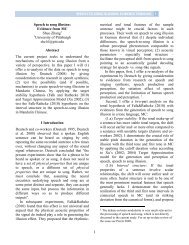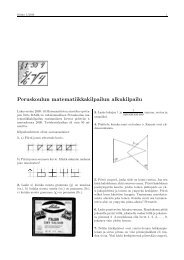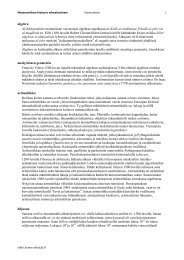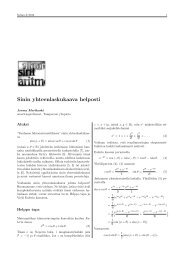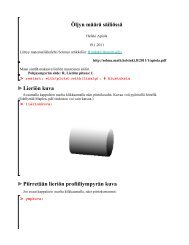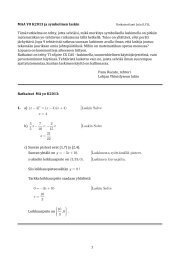Pronunciation of mathematical expressions
Pronunciation of mathematical expressions
Pronunciation of mathematical expressions
Create successful ePaper yourself
Turn your PDF publications into a flip-book with our unique Google optimized e-Paper software.
<strong>Pronunciation</strong> <strong>of</strong> <strong>mathematical</strong> <strong>expressions</strong><br />
17.2.1999/H. Väliaho<br />
The pronunciations <strong>of</strong> the most common <strong>mathematical</strong> <strong>expressions</strong> are given in the list<br />
below. In general, the shortest versions are preferred (unless greater precision is necessary).<br />
1. Logic<br />
∃ there exists<br />
∀ for all<br />
p ⇒ q p implies q / if p, then q<br />
p ⇔ q p if and only if q /p is equivalent to q / p and q are equivalent<br />
2. Sets<br />
x ∈ A x belongs to A / x is an element (or a member) <strong>of</strong> A<br />
x /∈ A x does not belong to A / x is not an element (or a member) <strong>of</strong> A<br />
A ⊂ B A is contained in B / A is a subset <strong>of</strong> B<br />
A ⊃ B A contains B / B is a subset <strong>of</strong> A<br />
A ∩ B A cap B / A meet B / A intersection B<br />
A ∪ B A cup B / A join B / A union B<br />
A \ B A minus B / the difference between A and B<br />
A × B A cross B / the cartesian product <strong>of</strong> A and B<br />
3. Real numbers<br />
x + 1 x plus one<br />
x − 1 x minus one<br />
x ± 1 x plus or minus one<br />
xy xy / x multiplied by y<br />
(x − y)(x + y) x minus y, x plus y<br />
x<br />
y<br />
x over y<br />
= the equals sign<br />
x = 5 x equals 5 / x is equal to 5<br />
x �= 5 x (is) not equal to 5<br />
1
x ≡ y x is equivalent to (or identical with) y<br />
x �≡ y x is not equivalent to (or identical with) y<br />
x > y x is greater than y<br />
x ≥ y x is greater than or equal to y<br />
x < y x is less than y<br />
x ≤ y x is less than or equal to y<br />
0 < x < 1 zero is less than x is less than 1<br />
0 ≤ x ≤ 1 zero is less than or equal to x is less than or equal to 1<br />
|x| mod x / modulus x<br />
x 2 x squared / x (raised) to the power 2<br />
x 3 x cubed<br />
x 4 x to the fourth / x to the power four<br />
x n x to the nth / x to the power n<br />
x −n x to the (power) minus n<br />
√ x (square) root x / the square root <strong>of</strong> x<br />
3√ x cube root (<strong>of</strong>) x<br />
4√ x fourth root (<strong>of</strong>) x<br />
n√ x nth root (<strong>of</strong>) x<br />
(x + y) 2 x plus y all squared<br />
�<br />
x<br />
�2 y<br />
x over y all squared<br />
n! n factorial<br />
ˆx x hat<br />
¯x x bar<br />
˜x x tilde<br />
xi<br />
n�<br />
i=1<br />
ai<br />
4. Linear algebra<br />
xi / x subscript i / x suffix i / x sub i<br />
the sum from i equals one to n ai / the sum as i runs from 1 to n <strong>of</strong> the ai<br />
�x� the norm (or modulus) <strong>of</strong> x<br />
−−→<br />
OA OA / vector OA<br />
OA OA / the length <strong>of</strong> the segment OA<br />
A T A transpose / the transpose <strong>of</strong> A<br />
A −1 A inverse / the inverse <strong>of</strong> A<br />
2
5. Functions<br />
f(x) fx / f <strong>of</strong> x / the function f <strong>of</strong> x<br />
f : S → T a function f from S to T<br />
x ↦→ y x maps to y / x is sent (or mapped) to y<br />
f ′ (x) f prime x / f dash x / the (first) derivative <strong>of</strong> f with respect to x<br />
f ′′ (x) f double–prime x / f double–dash x / the second derivative <strong>of</strong> f with<br />
respect to x<br />
f ′′′ (x) f triple–prime x / f triple–dash x / the third derivative <strong>of</strong> f with respect<br />
to x<br />
f (4) (x) f four x / the fourth derivative <strong>of</strong> f with respect to x<br />
∂f<br />
∂x1<br />
∂ 2 f<br />
∂x2 1<br />
� ∞<br />
0<br />
lim<br />
x→0<br />
lim<br />
x→+0<br />
lim<br />
x→−0<br />
the partial (derivative) <strong>of</strong> f with respect to x1<br />
the second partial (derivative) <strong>of</strong> f with respect to x1<br />
the integral from zero to infinity<br />
the limit as x approaches zero<br />
the limit as x approaches zero from above<br />
the limit as x approaches zero from below<br />
log e y log y to the base e / log to the base e <strong>of</strong> y / natural log (<strong>of</strong>) y<br />
ln y log y to the base e / log to the base e <strong>of</strong> y / natural log (<strong>of</strong>) y<br />
Individual mathematicians <strong>of</strong>ten have their own way <strong>of</strong> pronouncing <strong>mathematical</strong> <strong>expressions</strong><br />
and in many cases there is no generally accepted “correct” pronunciation.<br />
Distinctions made in writing are <strong>of</strong>ten not made explicit in speech; thus the sounds fx may<br />
be interpreted as any <strong>of</strong>: fx, f(x), fx, F X, F X, −−→<br />
F X . The difference is usually made clear<br />
by the context; it is only when confusion may occur, or where he/she wishes to emphasise<br />
the point, that the mathematician will use the longer forms: f multiplied by x, the function<br />
f <strong>of</strong> x, f subscript x, line F X, the length <strong>of</strong> the segment F X, vector F X.<br />
Similarly, a mathematician is unlikely to make any distinction in speech (except sometimes<br />
a difference in intonation or length <strong>of</strong> pauses) between pairs such as the following:<br />
x + (y + z) and (x + y) + z<br />
√ ax + b and √ ax + b<br />
a n − 1 and a n−1<br />
The primary reference has been David Hall with Tim Bowyer, Nucleus, English for Science<br />
and Technology, Mathematics, Longman 1980. Glen Anderson and Matti Vuorinen have<br />
given good comments and supplements.<br />
3


